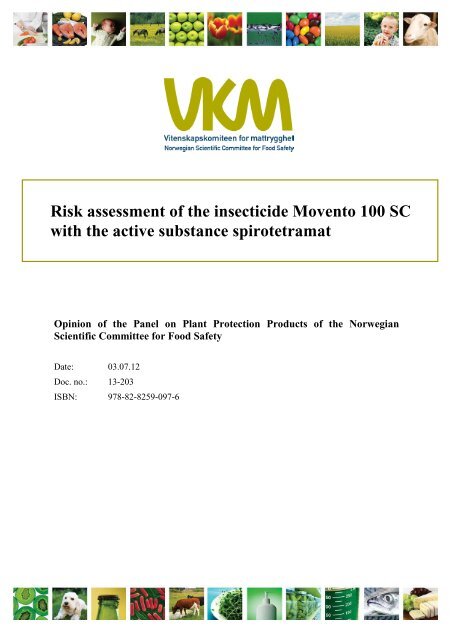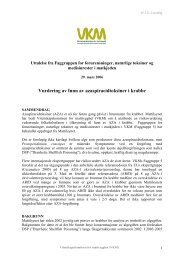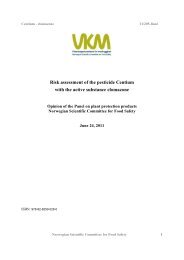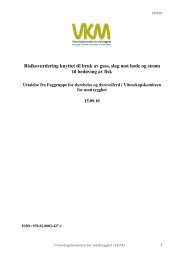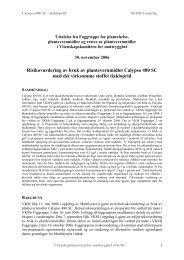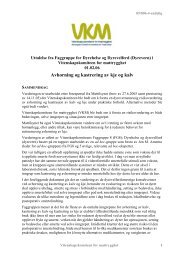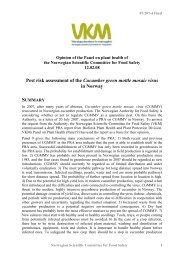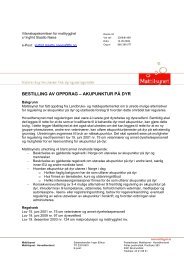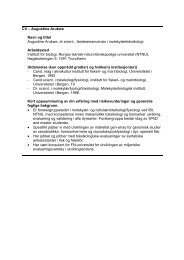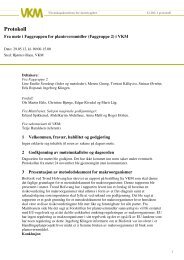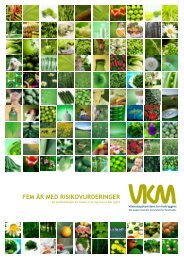Risk assessment of the insecticide Movento 100 SC with the active ...
Risk assessment of the insecticide Movento 100 SC with the active ...
Risk assessment of the insecticide Movento 100 SC with the active ...
Create successful ePaper yourself
Turn your PDF publications into a flip-book with our unique Google optimized e-Paper software.
Norwegian Scientific Committee for Food Safety (VKM) 13-203ContributorsPersons working for VKM, ei<strong>the</strong>r as appointed members <strong>of</strong> <strong>the</strong> Committee or as ad hocexperts, do this by virtue <strong>of</strong> <strong>the</strong>ir scientific expertise, not as representatives for <strong>the</strong>iremployers. The Civil Services Act instructions on legal competence apply for all workprepared by VKM.Assessed byVKMs Panel on plant protection products:Line Emilie Sverdrup (Chair), Christine Bjørge, Ole Martin Eklo, Merete Grung, TorstenKällqvist, Ingeborg Klingen, Marit Låg, Erik Ropstad, Steinar Øvrebø.VKM Scientific coordinatorEdgar Rivedal3
Norwegian Scientific Committee for Food Safety (VKM) 13-203For aquatic organisms in surface water, <strong>the</strong> risk is considered minimal, provided that a 5 mbuffer zone to open water is used.BackgroundVKM performs risk <strong>assessment</strong>s in <strong>the</strong> context <strong>of</strong> pesticide registration, cf. Regulation onPesticides § 4. The Norwegian Food Safety Authority, National Registration Section, isresponsible for reviewing and evaluating <strong>the</strong> documentation submitted by <strong>the</strong> pesticidenotifier. The Norwegian Food Safety Authority takes <strong>the</strong> final regulatory action regardingregistration or deregistration <strong>of</strong> pesticides based on VKMs risk <strong>assessment</strong>, along <strong>with</strong> acomparative <strong>assessment</strong> <strong>of</strong> risk and benefits, and <strong>the</strong> availability <strong>of</strong> alternatives (<strong>the</strong> principle<strong>of</strong> substitution).The Norwegian Food Safety Authority submitted a request on April 18, 2013 for VKM toperform a risk <strong>assessment</strong> on use <strong>of</strong> <strong>the</strong> pesticide <strong>Movento</strong> <strong>100</strong> <strong>SC</strong> containing <strong>the</strong> <strong>active</strong>substance spirotetramat. The risk <strong>assessment</strong> was finalized in June, 2013.Terms <strong>of</strong> reference<strong>Movento</strong> <strong>100</strong> <strong>SC</strong> is a new product containing <strong>the</strong> new <strong>active</strong> substance spirotetramat. Theintended use is as an <strong>insecticide</strong> in stone fruit, pome fruit, vegetables and ornamentalsoutdoors, and lettuce, tomatoes and cucumbers in greenhouses.In this regard, The Norwegian Food Safety Authority would like an <strong>assessment</strong> <strong>of</strong> <strong>the</strong>following:• The human health risk for operators related to <strong>the</strong> properties <strong>of</strong> <strong>Movento</strong> <strong>100</strong> <strong>SC</strong> andspirotetramat. The Panel is in particular asked to look at <strong>the</strong> following:o The human health relevance <strong>of</strong> <strong>the</strong> observed effects <strong>of</strong> spirotetramat on thyroidhormones, brain, thymus and body weight observed in dogs.o The human health relevance <strong>of</strong> <strong>the</strong> reproductive effects <strong>of</strong> spirotetramatobserved in rats.• The fate and behaviour in <strong>the</strong> environment and <strong>the</strong> ecotoxicological effects and risks<strong>with</strong> regard to <strong>the</strong> properties <strong>of</strong> <strong>Movento</strong> <strong>100</strong> <strong>SC</strong> and spirotetramat.5
Norwegian Scientific Committee for Food Safety (VKM) 13-2031 Background documentationVKM’s risk <strong>assessment</strong> is based on <strong>the</strong> Norwegian Food Safety Authority’s evaluation <strong>of</strong> <strong>the</strong>documentation submitted by <strong>the</strong> applicant. The Norwegian Food Safety Authority publishesboth <strong>the</strong>ir evaluation <strong>of</strong> <strong>Movento</strong> <strong>100</strong> <strong>SC</strong> and <strong>the</strong>ir final regulatory action on <strong>the</strong> registration<strong>of</strong> <strong>the</strong> pesticide product at <strong>the</strong>ir homepage www.Mattilsynet.no.2 ProcedureThe first three steps <strong>of</strong> <strong>the</strong> risk <strong>assessment</strong> (hazard identification, hazard characterization and<strong>assessment</strong> <strong>of</strong> exposure) are performed by <strong>the</strong> Norwegian Food Safety Authority and involvean <strong>assessment</strong> <strong>of</strong> <strong>the</strong> documentation submitted by <strong>the</strong> pesticide notifier. The resulting reporton hazard identification, hazard characterization and <strong>assessment</strong> <strong>of</strong> exposure, from which <strong>the</strong>summary is included in <strong>the</strong> present document, is <strong>the</strong>n reviewed by VKM. This review mayresult in some amendments in <strong>the</strong> original documents <strong>of</strong> both <strong>the</strong> summary and <strong>the</strong> full reportissued by <strong>the</strong> Norwegian Food Safety Authority. The fourth step (risk characterization) isbased on <strong>the</strong> three first steps and is VKM’s conclusions or risk <strong>assessment</strong>.2.1 HEALTH RISK ASSESSMENTThe <strong>assessment</strong> <strong>of</strong> health risk <strong>of</strong> pesticides is based on <strong>the</strong> adverse effects produced by <strong>the</strong><strong>active</strong> substance and product in several experimental test systems including long term animalstudies. On <strong>the</strong> basis <strong>of</strong> this, limits <strong>of</strong> exposure which represent no health risk are determined.The limits take into account <strong>the</strong> uncertainties <strong>of</strong> extrapolating data from animals to humansand are compared to <strong>the</strong> operator exposure and human exposure to possible residues in food.The UKPoem and <strong>the</strong> German model are used to estimate operator exposure. The models arebased on a limited number <strong>of</strong> studies and are not validated. Thus, <strong>the</strong> models may not alwaysbe sufficiently representative for Norwegian conditions. The limitations <strong>of</strong> model estimates <strong>of</strong>exposure are taken into consideration when <strong>the</strong> calculated level <strong>of</strong> exposure is close to <strong>the</strong>threshold limit for acceptable operator exposure (Acceptable Operator Exposure Level;AOEL). VKM uses <strong>the</strong> 75 percentile <strong>of</strong> exposure <strong>assessment</strong> for both UK poem and Germanmodel. VKM has to base <strong>the</strong> <strong>assessment</strong> on <strong>the</strong> models whenever exposure data for <strong>the</strong>product is not present.VKM makes use <strong>of</strong> a higher safety factor when calculating AOEL and ADI in cases where <strong>the</strong>product contains critical <strong>active</strong> substances <strong>with</strong> serious adverse inherent properties (toxic toreproduction or carcinogenic).In order to describe <strong>the</strong> exceeding <strong>of</strong> maximum tolerated dose, VKM makes use <strong>of</strong> a scale.The scale is based on <strong>the</strong> ratio between <strong>the</strong> estimated exposure based on models or measuredexposure in field studies and <strong>the</strong> Acceptable Operator Exposure Level (AOEL). In caseswhere <strong>the</strong> estimated exposure significantly exceeds AOEL, <strong>the</strong> use <strong>of</strong> <strong>the</strong> products may leadto increased risk for health effects.The following scale is used:Very high excess <strong>of</strong> AOEL more than 500% <strong>of</strong> <strong>the</strong> limitHigh excess <strong>of</strong> AOEL 300 – 500% <strong>of</strong> <strong>the</strong> limitMedium excess <strong>of</strong> AOEL 150-300% <strong>of</strong> <strong>the</strong> limit6
Norwegian Scientific Committee for Food Safety (VKM) 13-203Moderate excess <strong>of</strong> AOELThe limit is not exceeded<strong>100</strong>-150% <strong>of</strong> <strong>the</strong> limitVKM may also consider co-formulants in <strong>the</strong> product when risk is to be determined.Consequently, if a product contains critical co-formulants it may be assessed to representhigher risk than what <strong>the</strong> inherent properties <strong>of</strong> <strong>active</strong> substances imply.2.2 ENVIRONMENTAL RISK ASSESSMENTThe environmental risk <strong>assessment</strong> <strong>of</strong> pesticides involves predictions <strong>of</strong> exposureconcentrations in various environmental compartments (e.g. soil and surface waters) that mayoccur after application <strong>of</strong> <strong>the</strong> pesticide. These predicted effect concentrations (PECs) arecompared to exposure levels that are known to cause toxic effects to important groups <strong>of</strong>organisms representing <strong>the</strong> environmental compartments.The environmental fate and possible ecotoxicological effects <strong>of</strong> pesticides are investigated inseveral laboratory- and field experiments. In environmental risk <strong>assessment</strong>s <strong>of</strong> pesticides,Predicted Environmental Concentrations (PECs) are estimated by use <strong>of</strong> different scenariosfor different parts <strong>of</strong> <strong>the</strong> environment (terrestrial, aquatic). The first parameter estimated isusually <strong>the</strong> initial concentration (PIEC, Predicted Initial Environmental Concentration), e.g.<strong>the</strong> concentration just after application (usually spraying). PIEC in soil is calculated assuminga homogenous distribution <strong>of</strong> areal dose in <strong>the</strong> upper 5 cm soil layer. For surface water, <strong>the</strong>PIEC is based on deposition <strong>of</strong> pesticides from spray drift in a standard size water body. Thecalculations are performed <strong>with</strong> application <strong>of</strong> buffer zones between <strong>the</strong> sprayed area and <strong>the</strong>water body.The fur<strong>the</strong>r exposure regime in different compartments is affected on <strong>the</strong> fate <strong>of</strong> <strong>the</strong> pesticide.The fate is dependent on processes such as photo degradation, hydrolysis, biodegradation andsorption to soil particles. These processes are studied in several standardised laboratory tests.In addition, field tests are used to study <strong>the</strong> dissipation <strong>of</strong> <strong>the</strong> pesticide in various agriculturalsoils. Based on <strong>the</strong> experimental fate studies, factors describing different fate processes maybe derived and used in models that describe <strong>the</strong> fate <strong>of</strong> <strong>the</strong> pesticide in <strong>the</strong> soil as well as <strong>the</strong>transport to surface water and ground water. The concentrations <strong>of</strong> <strong>the</strong> pesticide in water areestimated by use <strong>of</strong> models <strong>with</strong> relevant scenarios based on EU’s FOCUS-scenarios. Themodels produce maximum PEC and average PEC calculated for specified periods afterpesticide application. In <strong>the</strong> surface water scenarios PEC is also calculated for <strong>the</strong> sedimentphase.Then <strong>the</strong> Toxicity Exposure Ratio (TER) is estimated for different groups <strong>of</strong> organisms. TheTER is calculated as <strong>the</strong> ratio between <strong>the</strong> toxicity for <strong>the</strong> organism in question (expressed asLC50, EC50, NOEC etc., depending on organism and study type) and PEC or PIEC. Triggervalues for TER, which express <strong>the</strong> acceptability <strong>of</strong> <strong>the</strong> risk for different organisms, have beendefined by <strong>the</strong> EU. The risk is considered minimal when <strong>the</strong> TER does not exceed <strong>the</strong> triggervalue.In <strong>the</strong> terrestrial environment, <strong>the</strong> risk for toxic effects on bees and non-target arthropods isassessed according to o<strong>the</strong>r criteria. Hazard quotients for oral- (HQ O ) and contact toxicity(HQ C ) are estimated for bees. HQ O or HQ C is <strong>the</strong> ratio between <strong>the</strong> standardized area dose <strong>of</strong><strong>the</strong> product (g a.s./ha) and acute toxicity for <strong>the</strong> bee (LD50, µg <strong>active</strong> ingredient/bee). Fieldexperiments and expert evaluation is triggered whenever <strong>the</strong> hazard quotient is above 50.7
Norwegian Scientific Committee for Food Safety (VKM) 13-2033 Summary by <strong>the</strong> Norwegian Food Safety Authority(hazard identification, hazard characterization and<strong>assessment</strong> <strong>of</strong> exposure)<strong>Movento</strong> <strong>100</strong> <strong>SC</strong> is a new product containing <strong>the</strong> new <strong>active</strong> substance spirotetramat.<strong>Movento</strong> <strong>100</strong> <strong>SC</strong> is an aqueous suspension concentrate (<strong>SC</strong>) containing <strong>100</strong> g/L <strong>of</strong> <strong>the</strong> <strong>active</strong>substance. The application is for use against biting and sucking insects in apple, pear, plum,cherries, white-, red-, savoy- and spring cabbage, Brussels sprouts, cauliflower, broccoli, kale,Chinese cabbage, lettuce grown in field and in greenhouse, tomatoes and cucumbers ingreenhouse and ornamentals outdoors (plant nurseries and urban landscape).<strong>Movento</strong> <strong>100</strong> <strong>SC</strong> belongs to <strong>the</strong> main chemical group “Inhibitors <strong>of</strong> acetyl CoA carboxylase”.This is an <strong>insecticide</strong> <strong>with</strong> contact and ingestion effect against aphids, scale insects,whiteflies, psyllids, gall midges, thrips and mites. The <strong>active</strong> ingredient spirotetramatpenetrates <strong>the</strong> plant tissue (leaves) and is distributed systemically in <strong>the</strong> xylem and phloem,leading to insect death <strong>with</strong>in 2 to 5 days.In <strong>the</strong> enclosed documentation it is noted that <strong>Movento</strong> <strong>100</strong> <strong>SC</strong> is gentle against beneficialorganisms, including biological control agents and bees. <strong>Movento</strong> <strong>100</strong> <strong>SC</strong> is classified byIOBC as harmless or slightly harmful to beneficial organisms, and could be used in integratedpest management (IPM).Pome fruit is <strong>the</strong> largest crop for use <strong>of</strong> <strong>Movento</strong> <strong>100</strong> <strong>SC</strong>, proposed application dose is 2250ml <strong>Movento</strong> <strong>100</strong> <strong>SC</strong>/ha (225 g spirotetramat/ha), and maximal application number is two perseason. Based on <strong>the</strong> product’s use in pome fruit, <strong>the</strong> standardized area dose is set to 2250ml/ha (225 g a.s/ha), corresponding to 225 ml/daa (22,5 g a.s/daa).3.1 IDENTITY AND PHYSICAL/CHEMICAL DATAProduct name: <strong>Movento</strong> <strong>100</strong> <strong>SC</strong>Active substance:Formulation:Concentration <strong>of</strong><strong>active</strong> substance:IUPAC-name:spirotetramatAqueous suspension concentrate (<strong>SC</strong>)<strong>100</strong> g/LCAS number: 203313-25-1cis-4-(ethoxycarbonyloxy)-8-methoxy-3-(2,5-xylyl)-1-azaspiro[4.5]dec-3-en-2-oneStructural formula:9
Norwegian Scientific Committee for Food Safety (VKM) 13-203<strong>with</strong> dogs, Bayer Crop Science (BCS) has issued a position paper arguing that brain ventricledilation has been observed in o<strong>the</strong>r BCS dog studies and is <strong>of</strong> hereditary origin and nottreatment-related. This is also <strong>the</strong> evaluation <strong>of</strong> <strong>the</strong> USEPA. According to information in <strong>the</strong>addendum to <strong>the</strong> DAR, <strong>the</strong> observed brain dilatation is also considered as an equivocal effectby <strong>the</strong> RMS. However, when this was discussed at an EU peer review expert meeting onspirotetramat, it was concluded that, based on <strong>the</strong> concurrent control and historical controldata, it cannot be excluded that it is treatment-related.Notably, <strong>the</strong> thyroid and thymus were unaffected in rats at any dose, while testicularhistopathology was not observed in dogs.In mice, no adverse effects <strong>of</strong> any kind were observed upon testing spirotetramat orally up to<strong>the</strong> limit dose (7000 ppm).Notable, in vitro results from a comparative metabolism study using hepatocytes from malerats, mice, and humans revealed species differences in <strong>the</strong> metabolism <strong>of</strong> spirotetramat.Specifically, mouse hepatocytes were better able than rat or human liver cells to metabolizespirotetramat-enol via glucuronidation. Potentially lower levels <strong>of</strong> <strong>the</strong> enol metabolite in micein vivo may account for <strong>the</strong> lack <strong>of</strong> testicular toxicity observed in this species. However, itcannot be excluded that testicular toxicity would occur in humans, who seem to have asignificantly lower rate <strong>of</strong> glucuronidation than mice.3.2.1.5 Chronic toxicity and carcinogenicityChronic toxicity/carcinogenicity studies in rats following dietary exposure to spirotetramat for1 and 2 years, and in mice following dietary exposure to spirotetramat for 18 months, did notreveal any treatment-related increase in tumour incidence in ei<strong>the</strong>r sex.In rats, target organs were kidney at medium and high doses in both sexes, and liver infemales exposed to <strong>the</strong> high dose. Increased incidence <strong>of</strong> accumulation <strong>of</strong> alveolarmacrophages was observed in both rat studies at medium and high dose males and high dosefemales. O<strong>the</strong>r effects included abnormal spermatozoa or increased incidence <strong>of</strong> exfoliatedgerm cells in high dose male rats in both rat studies, although only statistically significant in<strong>the</strong> 2 year study.A Functional Observational Battery <strong>assessment</strong> (motor activity, grip strength, and sensoryreactivity to stimuli <strong>of</strong> different types including e.g., visual, auditory, and proprioceptivestimuli) on 10 rats/sex/dose conducted during <strong>the</strong> last month <strong>of</strong> <strong>the</strong> 1 year chronic study didnot provide any indication <strong>of</strong> treatment-related neurological effects.In mice, no adverse findings were observed up to <strong>the</strong> limit dose following long-term treatment<strong>with</strong> spirotetramat.3.2.1.6 Reproductive and developmental toxicityReproductive toxicity and developmental toxicity <strong>of</strong> spirotetramat was investigated in a twogeneration study and a one generation range-finding study in rats, and in developmentalstudies in rat and rabbit. In addition, a supplementary developmental study in rats wasperformed to clarify <strong>the</strong> results <strong>of</strong> <strong>the</strong> main study.Results <strong>of</strong> <strong>the</strong> 2-generation reproductive toxicity study in rats provided evidence <strong>of</strong> malereproductive toxicity <strong>with</strong> abnormal sperm cell morphology and effects on reproductiveperformance, resulting in no pregnancies at high dose. These findings were supported byresults <strong>of</strong> a 1- generation range-finding study. Renal toxicity was observed in <strong>the</strong> F1-adults in12
Norwegian Scientific Committee for Food Safety (VKM) 13-203<strong>the</strong> 2-, but not <strong>the</strong> 1-generation study and <strong>of</strong>fspring toxicity was observed to be limited toreduced body weights.The applicant (BCS) has issued a position paper on "High dose reproductive effects in malerats and <strong>the</strong>ir relevance to humans" (Temerowski, 2008). In this paper, BCS argues thatspirotetramat is not considered to represent a reproductive hazard to humans at <strong>the</strong> expectedlow dose exposure scenarios routinely generated through <strong>the</strong> agricultural use <strong>of</strong> <strong>the</strong> chemical,or even at very high dose accidental exposure. According to BCS, <strong>the</strong> testicular toxicityobserved in <strong>the</strong> 2-generation rat study is not relevant for humans, as humans have <strong>the</strong> abilityto conjugate spirotetramat-enol and <strong>the</strong>refore are expected to be less sensitive than rats toeffects <strong>of</strong> spirotetramat on <strong>the</strong> male reproductive system. Results <strong>of</strong> <strong>the</strong> comparative in vitrotoxicokinetic study, do indeed suggest that humans are able to conjugate spirotetramat-enol.However, this conjugation occurred to a five-times lesser extent than in mice where noreproductive toxicity was observed. To what extent a low level <strong>of</strong> this conjugation protectsagainst reproductive effects induced by spirotetramat has not been established, and it can<strong>the</strong>refore not be concluded that testicular toxicity only occurs in species unable to conjugatespirotetramat-enol (rats). Fur<strong>the</strong>rmore, as pointed out by <strong>the</strong> RMS, it cannot be excluded thato<strong>the</strong>r metabolites can cause effects similar to those induced by spirotetramat – enol. Inaccordance <strong>with</strong> <strong>the</strong> RMS and conclusions made at an EU peer review expert meeting, it is<strong>the</strong>refore suggested that spirotetramat is classified as category 3 reproductive substance <strong>with</strong>R62 (Possible risk <strong>of</strong> impaired fertility).In <strong>the</strong> developmental toxicity study in rats (Klaus 2004), <strong>of</strong>fspring toxicity was observed atmaternal toxicity level. In addition, increased incidences <strong>of</strong> skeletal malformations anddeviations were observed at <strong>the</strong> mid and high dose. Equivocal retarded ossification wasfur<strong>the</strong>r investigated in a supplementary study and was not considered treatment related. Thedevelopmental NOAEL was set at 140 mg/kg bw/day. In accordance <strong>with</strong> <strong>the</strong> RMS andconclusions made at an EU peer review expert meeting, it is based on <strong>the</strong> increased incidences<strong>of</strong> skeletal malformations and skeletal deviations in rats at maternally toxic levels, suggestedthat spirotetramat is classified as category 3 reproductive substance <strong>with</strong> R63 (Possible risk <strong>of</strong>harm to <strong>the</strong> unborn child).The developmental study in rabbit did not reveal evidence <strong>of</strong> primary embryotoxic orteratogenic potential <strong>of</strong> spirotetramat. Developmental variation and malformations were notconsidered treatment related and a developmental NOAEL <strong>of</strong> 160 mg/kg bw/day wassuggested by <strong>the</strong> reviewer. With respect to <strong>the</strong> rabbit study, it was at <strong>the</strong> EU peer reviewexpert meeting on spirotetramat agreed upon that <strong>the</strong> maternal NOAEL is 10 mg/kg bw perday and <strong>the</strong> developmental NOAEL is 160 mg/kg bw per day. It was also concluded thatbased on <strong>the</strong> available data it could not be decided whe<strong>the</strong>r <strong>the</strong> observed abortions (at 40 and160 mg/kg bw/d) were due to maternal or developmental toxicity.Two mechanistic studies to fur<strong>the</strong>r investigate <strong>the</strong> onset <strong>of</strong> testicular toxicity in rat and <strong>the</strong>testicular toxicity <strong>of</strong> <strong>the</strong> metabolite spirotetramat-enol were carried out. The results revealedthat repeated dosing is necessary to produce male reproductive effects. Based on <strong>the</strong> results <strong>of</strong><strong>the</strong> study in rats treated <strong>with</strong> <strong>the</strong> enol-metabolite, it was concluded that reproductive toxicityis caused by ei<strong>the</strong>r <strong>the</strong> parent compound or <strong>the</strong> enol-metabolite following enzymatic cleavage.3.2.1.7 NeurotoxicityNeurotoxicity <strong>of</strong> spirotetramat was investigated in one acute neurotoxicity study in rat. Nodata was available on subchronic (rat 90-day) and postnatal developmental neurotoxicity.13
Norwegian Scientific Committee for Food Safety (VKM) 13-203Clinical signs <strong>of</strong> toxicity and/or decreased motor activity were observed following a singledose <strong>of</strong> 200 mg/kg bw spirotetramat to rats. These effects were observed <strong>with</strong> greater severityat doses higher than 200 mg/kg bw in this study, as well as in a follow-up study in rats.In <strong>the</strong> larger database, following one-year administration <strong>of</strong> spirotetramat to dogs, braindilation <strong>with</strong> dose-related severity was observed in males at ≥ 600 ppm (20 mg/kg bw/day),while axonal degeneration in <strong>the</strong> hypothalamus was observed in one female at 1800 ppm (48mg/kg bw/day). Clinical signs <strong>of</strong> neurotoxicity (dehydration, swelling, decreased activity andreactivity, seizures and ataxia) were also observed in one male <strong>with</strong> brain dilation at <strong>the</strong>highest dose tested. Similar effects were not observed in ei<strong>the</strong>r rats or mice.3.2.1.8 Reference valuesADI: An acceptable daily intake (ADI) <strong>of</strong> 0.05 mg/kg bw/day is suggested, based on <strong>the</strong>NOAEL <strong>of</strong> 5 mg/kg bw/day obtained in <strong>the</strong> one-year oral toxicity study in <strong>the</strong> dog and anuncertainty factor <strong>of</strong> <strong>100</strong>.AOEL: An acceptable operator exposure level (AOEL) <strong>of</strong> 0.05 mg/kg bw/day is suggested,based on <strong>the</strong> NOAEL <strong>of</strong> 5 mg/kg bw/day obtained in <strong>the</strong> one-year oral toxicity study in <strong>the</strong>dog and an uncertainty factor <strong>of</strong> <strong>100</strong>ARfD: An acute reference dose (ARfD) <strong>of</strong> 1 mg/kg bw is suggested, based on <strong>the</strong> NOAEL <strong>of</strong><strong>100</strong> mg/kg bw obtained in <strong>the</strong> acute neurotoxicity study in <strong>the</strong> rat and applying an uncertaintyfactor <strong>of</strong> <strong>100</strong>3.2.1.9 Co-formulantsThe product, <strong>Movento</strong> <strong>SC</strong> <strong>100</strong> / Spirotetramat <strong>SC</strong> <strong>100</strong> (<strong>100</strong> g/l), contains 0.08 % <strong>of</strong> <strong>the</strong>preservative Preventol D7 (CAS no. 55965-84-9) and 0.12 % <strong>of</strong> <strong>the</strong> preservative Proxel GXL20% (CAS no. 2634-33-5) and meets <strong>the</strong> criteria for <strong>the</strong> following risk classifications: H315,H317, H319.3.2.2 MOVENTO <strong>SC</strong> <strong>100</strong>3.2.2.1 Acute toxicityAcute toxicity studies on <strong>Movento</strong> <strong>SC</strong> <strong>100</strong> were performed <strong>with</strong> spirotetramat <strong>SC</strong> <strong>100</strong> G,which according to <strong>the</strong> bridging statement submitted by <strong>the</strong> applicant does not significantlydiffer from <strong>Movento</strong> <strong>SC</strong> <strong>100</strong>. The formulation <strong>of</strong> Spirotetramat <strong>SC</strong> <strong>100</strong> G was non-toxic afteracute oral and dermal administration, and induced very low inhalation toxicity (transientungroomed hair coat in both males and females and accelerated breathing in females) to ratsafter nose-only administration. Hence, no classification for acute oral, dermal and inhalationtoxicity is required.3.2.2.2 Irritation and sensitizationIrritation and sensitisation studies on <strong>Movento</strong> <strong>SC</strong> <strong>100</strong> were performed <strong>with</strong> spirotetramat <strong>SC</strong><strong>100</strong> G, which according to <strong>the</strong> bridging statement submitted by <strong>the</strong> applicant does notsignificantly differ from <strong>Movento</strong> <strong>SC</strong> <strong>100</strong>. Spirotetramat <strong>SC</strong> <strong>100</strong> G was not found to beirritating to <strong>the</strong> eye and skin. However, based on a test conducted <strong>with</strong> a similar formulationexpected to exhibit similar effects as Spirotetramat <strong>SC</strong> <strong>100</strong> G, <strong>the</strong> formulation is consideredskin sensitizing and should be classified accordingly (R43 - May cause sensitisation by skincontact).14
Norwegian Scientific Committee for Food Safety (VKM) 13-2033.2.2.3 Dermal absorptionDermal absorption <strong>of</strong> [14C]-Spirotetramat was investigated in one in vivo study <strong>with</strong> malerats using <strong>the</strong> OD 150 formulation, and in two in vitro studies using human and rat skin, one<strong>with</strong> <strong>the</strong> OD 150 formulation and one <strong>with</strong> <strong>the</strong> <strong>SC</strong> 240 formulation. Based on <strong>the</strong>se studiesand discussions at an EU peer review meeting, <strong>the</strong> following values are proposed for dermalabsorption <strong>of</strong> <strong>Movento</strong> <strong>SC</strong> <strong>100</strong>: 1% and 10 %, for <strong>the</strong> low and high dilution respectively.3.2.2.4 Operator exposureFor <strong>the</strong> scenarios calculated, <strong>the</strong> results <strong>of</strong> <strong>the</strong> exposure estimations according to <strong>the</strong> UKPOEM and <strong>the</strong> German model and to application in greenhouses do not exceed <strong>the</strong> proposedsystemic AOEL <strong>of</strong> 0.05 mg/kg bw/d, even if no personal protective equipment (PPE) is used,<strong>with</strong> <strong>the</strong> following exceptions:• According to <strong>the</strong> UKPOEM model (but not <strong>the</strong> German model) when used <strong>with</strong>outany PPE against pest insects in apples grown in field, when applying a tractormounted/trailedbroadcast air-assisted sprayer• According to both <strong>the</strong> UKPOEM and German model, when used <strong>with</strong>out any PPEagainst pest insects in apples grown in field, when applying a hand held sprayer.Notably, no exposure operator exposure estimates exceeded <strong>the</strong> proposed systemic AOEL <strong>of</strong>spirotetramat <strong>of</strong> 0.05 mg/kg bw/d when assuming use <strong>of</strong> gloves during mixing and loading,and <strong>the</strong> use <strong>of</strong> gloves, coverall and sturdy footwear during application, in line <strong>with</strong> <strong>the</strong> skinsensitisationpotential and proposed R43 classification <strong>of</strong> spirotetramat.3.2.2.5 Bystanders and workers exposureEstimations <strong>of</strong> bystander exposure assuming PPE is used is not required since modelcalculations <strong>of</strong> operator exposures predict <strong>the</strong> systemic exposure <strong>of</strong> operators to be well<strong>with</strong>in <strong>the</strong> acceptable exposure levels.With respect to workers exposure, <strong>the</strong> calculated scenarios (tree fruits and ornamentalassuming arms, body and legs covered, but no use <strong>of</strong> gloves); <strong>the</strong> proposed systemic AOEL isslightly exceeded for tree fruits (<strong>with</strong> a worst case <strong>assessment</strong> <strong>of</strong> <strong>the</strong> initial DFR). In line <strong>with</strong><strong>the</strong> skin-sensitisation potential and proposed R43 classification <strong>of</strong> spirotetramat <strong>the</strong> use <strong>of</strong>gloves are recommended.3.2.3 RESIDUES IN FOOD OR FEEDResidues are not discussed in this report.3.3 ENVIRONMENTAL FATE AND ECOTOXICOLOGICAL EFFECTS3.3.1 ENVIRONMENTAL FATE AND BEHAVIOUR3.3.1.1 Degradation in soilSpirotetramat is rapidly hydrolysed to spirotetramat-enol (max occurrence set to <strong>100</strong>% <strong>of</strong>AR). Spirotetramat-enol is oxidised to spirotetramat-ketohydroxy (max occurrence 24% <strong>of</strong>AR), which is hydrolytically opened and transformed into spirotetramat-MA-amide (max15
Norwegian Scientific Committee for Food Safety (VKM) 13-203occurrence 5.2% <strong>of</strong> AR). The mineralisation <strong>of</strong> spirotetramat-MA-amide into CO 2 concludesthis primary pathway.The aerobic rate <strong>of</strong> degradation <strong>of</strong> spirotetramat is characterised as very high <strong>with</strong> DT500.10–0.30 days (geometric mean 0.20 days), DT90: 0.34-1.26 days. Spirotetramat-enol alsodegrades very quickly, but <strong>with</strong> pronounced biphasic kinetics. The DT50 is 0.02-0.18 days(geo. mean 0.05 days), DT90: 11-41 days. Spirotetramat-ketohydroxy had a medium to highdegradation rate <strong>with</strong> normalised DT50 values ranging from 1.5 to 14 days (geo. mean 4.5days), DT90: 5.1-56 days. Degradation <strong>of</strong> spirotetramat-MA-amide was fast <strong>with</strong> normalisedDT50 values ranging from 0.3-4.6 days (geo. mean 1.2 days), DT90 from 1.0-28 days. Thesoil photolysis metabolite 4-methoxy-cyclohexanone degraded very quickly <strong>with</strong> a DT50 < 1day.Non-extractable residues (NER) formed in amounts <strong>of</strong> 22-35 % <strong>of</strong> applied radioactivity (AR)in <strong>the</strong> spirotetramat study (by 1-3 days) and barely declined after this. In <strong>the</strong> spirotetramatenolstudy, formation <strong>of</strong> NER was even more pronounced <strong>with</strong> NER occurring at 4.2-28 % at0 days. The plateau concentration was reached after 1 day, ranging from 40-60 % <strong>of</strong> AR.Until study termination, NER did not decrease significantly. The majority <strong>of</strong> <strong>the</strong> NER wasfound in <strong>the</strong> fulvic acid fraction.Mineralisation was relatively high in both <strong>the</strong> spirotetramat and spirotetramat-enol studies.CO 2 formation was between 9.7 and 19 % <strong>of</strong> AR in <strong>the</strong> spirotetramat degradation study, whileCO 2 formation was even higher in <strong>the</strong> spirotetramat-enol study, ranging from 17 to 43 % <strong>of</strong>AR.The anaerobic primary degradation route is close to identical to <strong>the</strong> aerobic degradation route.Spirotetramat degraded very quickly (DT50 < 1 day).Photolysis is not considered an important route <strong>of</strong> degradation for spirotetramat in soil.The field dissipation <strong>of</strong> unlabelled spirotetramat and its metabolites was studied in four USfield trials in New York, Florida, California and Washington. These studies were notconsidered relevant for Norwegian conditions. Spirotetramat degraded fast <strong>with</strong> a dissipationhalf-life <strong>of</strong> 0.3-1.0 days (geometric mean 0.7 days) and DT90 values 1.1-3.5 days.Spirotetramat-enol and spirotetramat-ketohydroxy were <strong>the</strong> main metabolites. Thequantification <strong>of</strong> metabolite residues was compromised by <strong>the</strong> instability <strong>of</strong> spirotetramat-enolduring storage, and no DT50 values for <strong>the</strong> individual metabolites could be estimated.3.3.1.2 Sorption/mobilityThe sorption <strong>of</strong> spirotetramat can be classified as medium <strong>with</strong> Kf: 3.70-4.79 L/kg (arithmeticmean 4.08 L/kg) and Kfoc: 159-435 L/kg (arithmetic mean 281 L/kg). The sorption <strong>of</strong>spirotetramat-ketohydroxy can be classified as moderate <strong>with</strong> Kf: 0.51-2.21 L/kg (arithmeticmean 1.04 L/kg) and Kfoc: 41.0-99.1 L/kg (arithmetic mean 63.7 L/kg). The sorption <strong>of</strong>spirotetramat-MA-amide can be classified as low <strong>with</strong> Kf: 0.06-0.18 L/kg (arithmetic mean0.11 L/kg) and Kfoc: 4.4-25.5 L/kg (arithmetic mean 9.3 L/kg). The sorption <strong>of</strong> spirotetramatenolhad to be studied in a column leaching study. The Koc values derived from <strong>the</strong> columnleaching study represents <strong>the</strong> first and rapidly degrading phase. The sorption can be classifiedas moderate <strong>with</strong> Koc: 27-99 L/kg (arithmetic mean 55 L/kg)3.3.1.3 Degradation in waterThe rate <strong>of</strong> hydrolysis depended strongly on pH and on temperature. At 25 °C <strong>the</strong> DT50values <strong>of</strong> spirotetramat were 32.5, 8.6 and 0.32 days at pH 4, 7 and 9, respectively. Astemperature decreased, degradation rates decreased. The major degradation product was16
Norwegian Scientific Committee for Food Safety (VKM) 13-203spirotetramat-enol, which was shown to be hydrolytically stable in <strong>the</strong> same range <strong>of</strong>temperatures and pH.Aqueous photolysis can be considered to be an important degradation pathway forspirotetramat. In a sterilised buffer solution (pH 5), spirotetramat degraded quickly <strong>with</strong> ahalf-life <strong>of</strong> 2.7 days (corresponds to a DT50 <strong>of</strong> 20.2 days during natural summer lightconditions). In <strong>the</strong> dark control DT50 was 26.2 days. In natural water (pH 7.9) <strong>the</strong> DT50 wasfound to be 0.19 days. In <strong>the</strong> dark control DT50 was 1.5 days. The major transformationproducts in <strong>the</strong> natural sterilised water were methoxy-cyclohexyl-aminocarboxylic acid (11.3% AR) and methoxy-cyclohexanone (17.5 % AR). The main hydrolysis productspirotetramat-enol was also formed.Spirotetramat is not readily biodegradable.Aerobic water / sediment studies were conducted in two different test systems. Forspirotetramat, <strong>the</strong> degradation in <strong>the</strong> whole system can be classified as very high (DT50 < 1day). The maximum amount in sediment was 3.2 % <strong>of</strong> AR after 1 day. The major metaboliteswere spirotetramat-enol (max 99 % <strong>of</strong> AR) and spirotetramat-ketohydroxy (max 51% <strong>of</strong> AR).Spirotetramat-enol was shown to degrade slower in aquatic systems than in soil systems,degrading at a medium rate (whole system DT50 38 and 59 days). The distribution was max79 % <strong>of</strong> AR in water after 7 days and 37 % <strong>of</strong> AR in sediment after 60 days. Spirotetramatketohydroxywas stable in both <strong>of</strong> <strong>the</strong> studied systems. The distribution after 120 days wasmax 13% <strong>of</strong> AR in water and 28 % <strong>of</strong> AR in sediment. The maximum formation <strong>of</strong> nonextractableresidues (NER) was above 30 % <strong>of</strong> AR in both systems (max 36 % <strong>of</strong> AR). Themineralisation varied between <strong>the</strong> systems, but was relatively high, ranging from 5.9 to 24 %<strong>of</strong> AR.3.3.1.4 Fate in airCalculations using <strong>the</strong> Atkinson method estimate DT50 in <strong>the</strong> troposphere <strong>of</strong> 1.7 hours forboth spirotetramat and spirotetramat-enol, while a DT50 <strong>of</strong> 4.3 hours was estimated for 4-methoxy-cyclohexanone and 2.8 hours for 4-methoxy-cyclohexyl-aminocarboxylic acid(assumes 12-hour day and 1.5 × 106 OH- cm-3). Spirotetramat has a vapour pressure <strong>of</strong> 5.6 ×10-9 Pa at 20°C, and thus has a low volatility. No significant transfer to <strong>the</strong> atmosphere isexpected.3.3.2 ENVIRONMENTAL EXPOSURE3.3.2.1 SoilAccording to a simple model recommended by <strong>the</strong> EU working group FOCUS <strong>the</strong> highestexpected initial concentration (PIEC, predicted initial environmental concentration) in soilwill be as follows for spirotetramat, spirotetramat-enol, spirotetramat-ketohydroxy and 4-methoxy-cyclohexanone, respectively: 0.,1, 0.084, 0.032 and 0.003 mg/kg (75 g/ha on baresoil in ornamentals returns <strong>the</strong> highest concentrations). Due to <strong>the</strong> fast degradation <strong>of</strong>spirotetramat and its metabolites, no accumulation in soil is expected.3.3.2.2 GroundwaterMetabolites considered relevant in groundwater are spirotetramat-enol, spirotetramatketohydroxy,spirotetramat-MA-amide and 4-methoxy-cyclohexanone (<strong>the</strong> latter from soilphotolysis). All nine EU FOCUS scenarios were modelled. Results were reported as <strong>the</strong> 80percentile concentration at 1 m depth over 20 years. Concentrations were below 0.001 μg/Lfor all scenarios. Hence, it is not expected that spirotetramat or any <strong>of</strong> its metabolites will17
Norwegian Scientific Committee for Food Safety (VKM) 13-203reach concentrations above <strong>the</strong> threshold level <strong>of</strong> 0.1 μg/L when <strong>the</strong> formulation <strong>Movento</strong> <strong>100</strong><strong>SC</strong> is applied according to <strong>the</strong> intended use.3.3.2.3 Surface waterModels developed by EU’s working group FOCUS estimate predicted environmentalconcentrations in surface water and sediment for different scenarios. PECsw values have beencalculated for <strong>the</strong> use in pome and stone fruit (application 2 x 225 g a.s./ha) and leafyvegetables (2 x75 g a.s./ha) up to Step 2 (Nor<strong>the</strong>rn EU). The highest PEC values resultedfrom <strong>the</strong> application in pome and stone fruit <strong>with</strong> PECsw <strong>of</strong> 11.79, 12.72, 6.33, 1.09 and 0.94μg/L for spirotetramat, spirotetramat-enol, spirotetramat-ketohydroxy, 4-methoxycyclohexanoneand 4-methoxy-cyclohexyl-aminocarboxylic acid, respectively. Thecorresponding PECsed values were 6.6, 6.35, 3.93, 0.03 and 0.09 μg/kg. Spray drift isassumed to be <strong>the</strong> main route <strong>of</strong> entry. As no Step 3 calculations were presented, <strong>the</strong>Norwegian Food Safety Authority considered a 5 m drift buffer for spirotetramat. Thisresulted in a PECsw value <strong>of</strong> 6.3 μg/L.3.3.3 EFFECTS ON TERRESTRIAL ORGANISMSWhere <strong>the</strong>re are indications that <strong>the</strong> plant protection product is more toxic than what can beexplained by <strong>the</strong> content <strong>of</strong> <strong>active</strong> substance (or studies are conducted only <strong>with</strong> <strong>the</strong> product),or identified metabolites are more toxic than <strong>the</strong> <strong>active</strong> substance, <strong>the</strong>se calculations areincluded in <strong>the</strong> summary below. If this is not <strong>the</strong> case, <strong>the</strong>se values and calculations areomitted.For mammals and birds, <strong>the</strong> risk <strong>assessment</strong> is performed according to <strong>the</strong> EU GuidanceDocument SANCO (2002). The EU triggers (birds and mammals) are >10 and >5 forTERacute and TERchronic, respectively.3.3.3.1 MammalsLow acute toxicity (LD50 > 2000 mg/kg bw/d)- In a rat multigenerational study <strong>the</strong>reproductive NOEC was toxicity 70.7/82.5 mg/kg bw/d (m/f). TER calculations forspirotetramat pass <strong>the</strong> EU triggers based on EU Tier 1 scenarios.3.3.3.2 BirdsLow acute oral toxicity (LD50 > 2000 mg/kg bw/d). NOEC from reproductive studies are 4mg/kg bw/d. Spirotetramat passes <strong>the</strong> EU trigger values for acute exposure (TERacute >600)according to <strong>the</strong> EU screening step <strong>with</strong> an application rate <strong>of</strong> 2x225 g a.s./ha in pome fruits.TERchronic fails <strong>the</strong> EU trigger based on tier 1 calculations, but pass <strong>the</strong> trigger in a highertier risk <strong>assessment</strong> for <strong>the</strong> insectivorous indicator species white Wagtail and Blue tit.3.3.3.3 BeesSpirotetramat shows low contact (LD50 ><strong>100</strong> μg/bee) and oral (LD50 >107 μg/bee) toxicityto bees. Hazard quotients for contact (Qhc) and oral exposure (Qho) pass <strong>the</strong> trigger value(
Norwegian Scientific Committee for Food Safety (VKM) 13-203exceeded <strong>the</strong> E<strong>SC</strong>ORT 2 trigger <strong>of</strong> 50 % effect (mortality) at doses at and above 42 g/ha. In afield study carried out in grape vines no dose-related, statistically significant effects wereobserved during <strong>the</strong> study period.3.3.3.5 EarthwormsSpirotetramat shows moderate acute toxicity (LC50 > 500 mg/kg d.w. soil). In a chronictoxicity study <strong>with</strong> <strong>the</strong> predominant soil metabolite spirotetramat-enol <strong>the</strong> NOEC is 32 mg/kgd.w. soil. TER calculations for spirotetramat pass <strong>the</strong> EU triggers for both acute (≥10) andchronic (≥5) toxicity.3.3.3.6 O<strong>the</strong>r soil macro organismsLow acute toxicity (LD50 > <strong>100</strong>0 mg a.s/kg d.w.soil, NOEC 316 mg a.s/kg d.w.soil). TERcalculations for spirotetramat pass <strong>the</strong> EU triggers both for acute (≥10) and chronic (≥5)toxicity.3.3.3.7 MicroorganismsThe effect <strong>of</strong> technical spirotetramat on N- and C-transformation in soil was studied in 28-days laboratory tests in accordance <strong>with</strong> OECD Guideline 216 and 217, respectively. Nosignificant effects above <strong>the</strong> 25% trigger were seen.3.3.3.8 Terrestrial plantsCorn (Zea mays) is <strong>the</strong> most sensitive species. The intended use <strong>of</strong> <strong>Movento</strong> <strong>100</strong> <strong>SC</strong> in pomefruit crops will not constitute an unacceptable risk <strong>of</strong> adjacent non-target plants provided abuffer zone <strong>of</strong> 3 meters is used.3.3.4 AQUATIC ORGANISMSWhere <strong>the</strong>re are indications that <strong>the</strong> plant protection product is more toxic than what can beexplained by <strong>the</strong> content <strong>of</strong> <strong>the</strong> <strong>active</strong> substances (or studies are only conducted <strong>with</strong> <strong>the</strong>product), or identified metabolites are more toxic than <strong>the</strong> <strong>active</strong> substances, <strong>the</strong>secalculations are included in <strong>the</strong> summary below. If this is not <strong>the</strong> case, <strong>the</strong>se values andcalculations are omitted.The TER calculations below are based on maximum PEC-values from FOCUS surface watermodelling and <strong>the</strong> lowest acute (LC50 or EC50) or chronic (NOEC) values for <strong>the</strong> differentorganism groups. FOCUS Step 2 is calculated for all tested substances. If <strong>the</strong> TER fails <strong>the</strong>triggers, PEC values based on drift when applying different buffer zones are calculated. TheEU triggers for TERacute and TERlong-term are ><strong>100</strong> and >10, respectively. PEC and TERvalues for <strong>the</strong> metabolites <strong>of</strong> spirotetramat are not included below, since <strong>the</strong>y all show lowertoxicity than spirotetramat. <strong>Movento</strong> <strong>100</strong> <strong>SC</strong> does not seem to be more toxic than can beexplained by <strong>the</strong> toxicity <strong>of</strong> spirotetramat.3.3.4.1 FishSpirotetramat is acutely toxic (96h LC50: 1.96-2.59 mg a.s./L), and showed moderate chronictoxicity (28d NOEC: 0.534 mg a.s./L) to fish. Spirotetramat-enol and 4-methoxycyclohexanone showed low acute toxicity (96h LC50: ><strong>100</strong> mg/L). <strong>Movento</strong> <strong>100</strong> <strong>SC</strong>showed moderate acute toxicity (96h LC50: 22.3 mg/L).Both acute and long-term TER calculations for spirotetramat pass <strong>the</strong> EU triggers based onStep 2 calculations.19
Norwegian Scientific Committee for Food Safety (VKM) 13-2033.3.4.2 InvertebratesSpirotetramat showed moderate to very high acute toxicity to invertebrates (48h EC50: 0.85->43 mg a.s./L), and low chronic toxicity (21d NOEC: 2.0 mg a.s./L) to Daphnia magna.Spiroteramat-enol and 4-methoxycyclohexanone showed low acute toxicity (96h LC50: ><strong>100</strong>mg/L) to D. magna. No studies <strong>with</strong> <strong>Movento</strong> <strong>100</strong> <strong>SC</strong> have been reported. The notifier arguesthat daphnids are less sensitive than fish, algae and sediment-dwelling organisms.Acute TER for use in fruit fail <strong>the</strong> EU trigger based on Step 2 calculations, but pass <strong>the</strong>trigger based on drift calculations <strong>with</strong> a 5 meter buffer zone. Long-term TER for use in fruitand both acute and long-term TER for use in vegetables pass <strong>the</strong> EU trigger based on Step 2calculations.3.3.4.3 Sediment dwelling organismsSpirotetramat is acutely toxic (48h EC50: 1.30 mg a.s./L) and showed moderate chronictoxicity (28d NOEC: 0.1 mg a.s./L (spiked water)) to chironomid larvae. Spirotetramat-enol,spirotetramat-ketohydroxy, 4-methoxycyclohexanone and spirotetramat-cis-metoxycyclohexylaminocarboxylic acid showed low to moderate acute toxicity (96h LC50: 75- ><strong>100</strong>mg/L) to chironomid larvae. <strong>Movento</strong> <strong>100</strong> <strong>SC</strong> is acutely toxic to chironomid larvae (48hEC50: 8.63 mg/L).Long-term TER for use in fruit fail <strong>the</strong> EU trigger based on Step 2 calculations, but pass <strong>the</strong>trigger based on drift calculations <strong>with</strong> a 5 meter buffer zone. Acute TER for use in fruit andboth acute and long-term TER for use in vegetables pass <strong>the</strong> EU trigger based on Step 2calculations.3.3.4.4 Aquatic plantsSpirotetramat and spirotetramat-enol are toxic to duckweed (14d EC50: 4.6-5.4 mg a.s./L).TER calculations for spirotetramat pass <strong>the</strong> EU triggers based on Step 2 calculations.3.3.4.5 AlgaeSpirotetramat showed very high toxicity to algae (72-96h EC50: 0.36-15 mg a.s./L).Spirotetramat-enol and 4-methoxycyclohexanone showed low toxicity (72h EC50: ><strong>100</strong>mg/L) to algae. <strong>Movento</strong> <strong>100</strong> <strong>SC</strong> showed low toxicity to algae (72h EC50: 134 mg/L).TER calculations for spirotetramat pass <strong>the</strong> EU triggers based on Step 2 calculations.3.3.4.6 MicroorganismsSpirotetramat showed low acute toxicity to wastewater microorganisms in activated sludge(3h EC50 >10 000 mg a.s./L).3.3.4.7 Microcosm/Mesocosm studiesNo information.3.3.4.8 BioconcentrationNo studies required for spirotetramat or <strong>the</strong> metabolites, since <strong>the</strong>y all have log Pow below<strong>the</strong> trigger <strong>of</strong> 3.3.4 DOSSIER QUALITY AND COMPLETENESSThe dossier is complete and is adequate as a basis for an evaluation <strong>of</strong> <strong>the</strong> <strong>active</strong> substance,metabolites and product.20
Norwegian Scientific Committee for Food Safety (VKM) 13-2034 <strong>Risk</strong> characterization4.1 SUMMARY OF HUMAN TOXICITY/INHERENT PROPERTIESIn <strong>the</strong> terms <strong>of</strong> reference VKM was requested to consider possible health risk for operatorsrelated to <strong>the</strong> properties <strong>of</strong> <strong>the</strong> <strong>active</strong> substance spirotetramat and <strong>the</strong> product <strong>Movento</strong> <strong>100</strong><strong>SC</strong> ; in particular <strong>the</strong> relevance <strong>of</strong> <strong>the</strong> effects <strong>of</strong> spirotetramat on thyroid hormones, brain,thymus and body weight observed in dogs, and <strong>the</strong> reproductive effects <strong>of</strong> spirotetramatobserved in rats.4.1.1 EFFECTS SEEN IN DOG STUDIESVKM discussed <strong>the</strong> seriousness <strong>of</strong> <strong>the</strong> effects in studies <strong>with</strong> dogs and concluded that thyroidand thymus glands are target organs in <strong>the</strong> oral subchronic toxicity studies, and that effectscould be observed from 19 mg/kg bw/day (600 ppm). Decreases in circulating thyroidhormone levels were detected in three studies, and should be considered as toxicologicallyrelevant. Fur<strong>the</strong>rmore, it cannot be excluded that <strong>the</strong> observed brain dilatation could betreatment-related. Higher doses <strong>of</strong> spirotetramat also induced decreased body weights.Thyroid and thyroid hormones: A dose–related decrease in thyroid hormones (T4 and T3)were observed in three different studies <strong>with</strong> spirotetramat, 28-days, 90-days and 1-year, bothin male and female dogs. The hormonal decreases were significant from 400 ppm, 150 ppmand 200 (600) ppm, respectively, in <strong>the</strong> three studies. The T4 and T3 levels were measured atvarious time-points during <strong>the</strong> studies, and <strong>the</strong> onset for significant reduction <strong>of</strong> T4 and/or T3varied. The declines in circulating thyroid hormones were observed at lower concentrationsthan those needed for induced changes in thyroid weight and thyroid histopathology. Reducedthyroid follicular size was noted in two dogs at 1800 ppm (equal to 55 mg/kg bw/day). Thus,it cannot be excluded that <strong>the</strong> observed decline in thyroid hormones could be an early event in<strong>the</strong> development <strong>of</strong> hypothyroidism, and should <strong>the</strong>refore be considered as toxicologicallyrelevant.Brain: Brain dilatation was observed in <strong>the</strong> 1-year study, and describes a condition where abrain ventricle is identified to be larger than expected. Dilated brain was observed in males at600 (mild) and 1800 ppm (moderate), and was noted in females, but only at 600 ppm(moderate); mild axonal degeneration was also detected in one female dog at 1800 ppm. Thenotifier (BCS) claimed that <strong>with</strong> a persistent incidence <strong>of</strong> only one individual dog per dosegroup (spirotetramat study and historical controls) and since brain ventricle dilation also hasbeen observed in o<strong>the</strong>r BCS dog studies, <strong>the</strong>re should be valid reasons to conclude that <strong>the</strong>phenomenon represents a pre-existing condition, and thus not treatment-related. VKMconcludes, however, that although brain ventricle dilation has been observed in o<strong>the</strong>r dogstudies, it cannot be excluded that this serious response could be treatment-related.Thymus and body weight: In addition to <strong>the</strong> thyroid, also <strong>the</strong> thymus gland is a target organfor spirotetramat in oral subchronic toxicity studies in dogs. Thymus involution was gradedmild in one male at 600 ppm and moderate in one male at 1800 ppm. The thymus changes(decreased size and weight, atrophy and involution) were observed at high concentrations(600-6400 ppm) in all three dog studies (28-, 90- and 365 days). The effects on thymus shouldbe considered toxicologically relevant.In <strong>the</strong> subchronic toxicity studies (28 and 90-days), a decrease in body weight, body weightgain, and food consumption was observed at <strong>the</strong> highest treatment doses (from 2,500 ppm and21
Norwegian Scientific Committee for Food Safety (VKM) 13-203higher). In <strong>the</strong> 1-year study <strong>the</strong>re were no compound-related effects on body weights, even at<strong>the</strong> highest concentration (1800 ppm). Thus, doses <strong>of</strong> 2,500 ppm spirotetramat and higherseem to affect <strong>the</strong> dog body weight.4.1.2 THE EFFECTS SEEN IN RAT STUDIESReproductive effects: In addition to testicular histopathology observed following subchronicand chronic exposure <strong>of</strong> male rats to spirotetramat, evidence <strong>of</strong> male reproductive toxicitywas provided in <strong>the</strong> 2-generation reproductive toxicity study. Abnormal sperm cells werereported in F1-generation male rats treated <strong>with</strong> 6000 ppm (419 mg/kg bw/day) spirotetramatin <strong>the</strong> diet, and decreased reproductive performance was also observed in one <strong>of</strong> <strong>the</strong>se males.The findings were supported by a 1-generation range-finding study. Renal toxicity wasobserved in <strong>the</strong> F1-adults in <strong>the</strong> 2-, but not <strong>the</strong> 1-generation study, and <strong>of</strong>fspring toxicity wasobserved to be limited to reduced body weights.In an investigative study designed to explore <strong>the</strong> time <strong>of</strong> onset <strong>of</strong> testicular toxicity in rats,decreased epididymal sperm counts were recorded after more than 10 days treatment to <strong>100</strong>0mg/kg bw/day by gavage. Repeated dosing, <strong>the</strong>refore, seems necessary to produce malereproductive toxicity in rats. In a second investigative study <strong>of</strong> a spirotetramat metabolite,male rats were treated by gavage <strong>with</strong> <strong>the</strong> enol metabolite (formed by enzymatic cleavage <strong>of</strong>parent compound) for 21 days at a dose <strong>of</strong> 800 mg/kg bw/day. Spermatotoxicity, abnormalsperm, and Sertoli cell vacuolation were observed in <strong>the</strong> testis-epididymides <strong>of</strong> treatedanimals. Therefore, male reproductive toxicity in rats is likely due to <strong>the</strong> enol metabolite (orfur<strong>the</strong>r oxidation products) <strong>of</strong> spirotetramat. The testicular toxicity was not observed in mice,probably due to <strong>the</strong> high conjugation <strong>of</strong> <strong>the</strong> enol metabolite <strong>with</strong> glucuronic acid(approximately 30%). The notifier claimed that based on a metabolic similarity between miceand humans, it is likely that humans are also less sensitive to <strong>the</strong> enol metabolite toxicity thanrats. However, VKM concludes that due to <strong>the</strong> low conjugation in human liver cells at highdoses (only 2%), as well as <strong>the</strong> far lower conjugation in humans compared to mice, it cannotbe assumed that humans are fundamentally different from rats <strong>with</strong> regard to sensitivity tospirotetramat. Thus, VKM concludes that <strong>the</strong> reproductive effect in rats could be relevant forhumans.Neurotoxicity: Clinical signs <strong>of</strong> toxicity and decreased motor activity were observedfollowing one single dose <strong>of</strong> 200 mg/kg bw spirotetramat to rats.4.1.3 ESTABLISHMENT OF REFERENCE VALUESNOAELVKM concludes on a NOAEL <strong>of</strong> 5 mg/kg bw/day (200 ppm) for spirotetramat based on 1-year toxicity study in dogs, and is <strong>of</strong> <strong>the</strong> opinion that <strong>the</strong> test substance-related decrease inthyroid hormone levels, thymus involution and brain dilation is relevant for humans.Fur<strong>the</strong>rmore, a NOAEL <strong>of</strong> <strong>100</strong> mg/kg bw/day based on <strong>the</strong> acute neurotoxicity study in rats isused to establish <strong>the</strong> ARfD value.ADIAn ADI <strong>of</strong> 0.05 mg/kg bw/day is proposed for spirotetramat based on applying a <strong>100</strong>-folduncertainty factor on <strong>the</strong> NOAEL <strong>of</strong> 5 mg /kg bw/day in <strong>the</strong> 1- year toxicity study in dogs.The uncertainty factor accounts for interspecies extrapolation (10X) and intraspeciesvariability (10X).22
Norwegian Scientific Committee for Food Safety (VKM) 13-203AOELAn AOEL <strong>of</strong> 0.05 mg/kg bw/day is proposed for spirotetramat based on <strong>the</strong> NOAEL <strong>of</strong> 5 mg/kg bw/day determined in <strong>the</strong> 1- year toxicity study in dogs.AR f DAn AR f D <strong>of</strong> 1 mg/kg bw/day is proposed for spirotetramat based on NOAEL <strong>of</strong> <strong>100</strong> mg/kgbw/day in <strong>the</strong> acute neurotoxicity study in rats.4.2 HEALTH RISK CHARACTERIZATION4.2.1 HEALTH RISK DUE TO HUMAN EXPOSUREVKM has based <strong>the</strong> risk characterization for operators on <strong>the</strong> summary from <strong>the</strong> NorwegianFood Safety Authority (section 5.5), and related this to <strong>the</strong> suggested AOEL value asindicated here in section 2.1.4.2.1.1 Operator, worker and bystander exposureOperator exposure:The AOEL for spirotetramat is not exceeded when applied in greenhouses, even if nopersonal protective equipment (PPE) is used. On fruit trees in field <strong>the</strong>re is a medium excess<strong>of</strong> AOEL <strong>with</strong>out PPE, but no excess <strong>with</strong> PPE (Gloves during mixing and loading, andgloves, coveralls and sturdy footwear during application).Worker and bystander exposure:The AOEL is slightly exceeded for fruit trees, and thus <strong>the</strong> use <strong>of</strong> gloves is recommended.4.2.2 HEALTH RISK DUE TO RESIDUES IN PRODUCTS FOR CONSUMPTIONNot included in <strong>the</strong> terms <strong>of</strong> reference.4.3 ENVIRONMENTAL FATE ASSESSMENTVKM was also asked to consider <strong>the</strong> fate and behaviour <strong>of</strong> <strong>Movento</strong> <strong>100</strong> <strong>SC</strong> and <strong>the</strong> <strong>active</strong>ingredient spirotetramat in <strong>the</strong> environment, and <strong>the</strong> ecotoxicological effects and risks related.4.3.1 DEGRADATION IN SOILSpirotetramat degrades very quickly to spirotetramat-enol in soil (DT50: 0.1 – 0.3 days). Therelevant metabolites are also degraded at high to medium rates. Spirotetramat and itsmetabolites are not expected to accumulate in soil.4.3.2 MOBILITY IN SOIL AND LEACHING TO GROUNDWATERSorption studies indicate medium sorption <strong>of</strong> spirotetramat to soil and moderate to lowsorption <strong>of</strong> <strong>the</strong> main metabolites. Due to <strong>the</strong> rapid degradation in soil, no significant leaching<strong>of</strong> spirotetramat to groundwater is expected. Leaching models show concentrations <strong>of</strong> relevantmetabolites below 0.001 µg/L for all FOCUS scenarios. Hence, VKM considers it unlikelythat spirotetramat or any <strong>of</strong> its metabolites will reach concentrations above <strong>the</strong> threshold level<strong>of</strong> 0.1 μg/L when <strong>the</strong> formulation <strong>Movento</strong> <strong>100</strong> <strong>SC</strong> is applied according to <strong>the</strong> intended use.4.3.3 SURFACE WATER CONCENTRATIONSSurface water concentrations <strong>of</strong> spirotetramat and <strong>the</strong> relevant metabolites have beencalculated using FOCUS models, step 2. Additional calculations were performed including a5 m buffer zone. VKM considers <strong>the</strong> calculated maximum PEC values as shown in section3.3.2 to be relevant for aquatic risk <strong>assessment</strong>.23
Norwegian Scientific Committee for Food Safety (VKM) 13-2034.4 ENVIRONMENTAL RISK CHARACTERIZATIONThe risk characterization <strong>of</strong> <strong>the</strong> product’s ecotoxicological effects on terrestrial and aquaticorganisms made by VKM is based on <strong>the</strong> summary from <strong>the</strong> Norwegian Food SafetyAuthority presented in section 3.3 and using <strong>the</strong> risk scale described in section 2.2.4.4.1 EFFECTS AND RISKS TO TERRESTRIAL ORGANISMSVKM concludes that <strong>the</strong> risk for toxic effects <strong>of</strong> spirotetramat to mammals, birds,earthworms, and soil microorganisms is minimal <strong>with</strong> <strong>the</strong> proposed application regime.Extended laboratory studies <strong>with</strong> non-target arthropods <strong>Movento</strong> <strong>100</strong> <strong>SC</strong> showed effectsabove <strong>the</strong> trigger <strong>of</strong> 50% mortality for one species <strong>of</strong> predatory mites (T. pyri) at and aboveapplication doses <strong>of</strong> 42 g/ha, while <strong>the</strong> proposed application rate is 225 g/ha. Although a fieldstudy did not show any effects on <strong>the</strong> mite fauna, VKM considers that in-field effects onsensitive species <strong>of</strong> predatory mites in <strong>the</strong> fields cannot be excluded.The acute contact and oral toxicity <strong>of</strong> spirotetramat to adult bees is low. Transient effects onhoney-bee brood were observed under worst-case scenarios in some semi-field studies.However, no adverse effects were observed in field studies and VKM concludes that <strong>the</strong> risk<strong>of</strong> adverse effects on bees is minimal providing that spirotetramat is not used on crops duringflowering or when bees are <strong>active</strong>ly foraging.4.4.2 EFFECTS AND RISK TO AQUATIC ORGANISMSVKM concludes that <strong>the</strong>re is a minimal risk for toxic effects <strong>of</strong> spirotetramat to fish, aquaticplants, and algae <strong>with</strong> <strong>the</strong> proposed application regime. For invertebrates and sedimentdwelling organisms, minimal risks are calculated provided that a 5 m buffer zone is used.4.5 QUALITY OF THE SUBMITTED DOCUMENTATIONVKM is <strong>of</strong> <strong>the</strong> opinion that <strong>the</strong> documentation submitted to VKM is adequate as a basis for anevaluation <strong>of</strong> <strong>the</strong> <strong>active</strong> substance, <strong>the</strong> metabolites, and for <strong>the</strong> technical material.5 Conclusion5.1 HEALTHVKM concludes that spirotetramat show toxic effects in dogs and rats that could be relevantfor humans. Thyroid and thymus glands are target organs in <strong>the</strong> oral subchronic toxicitystudies in dogs. Decreases in circulating thyroid hormone levels were detected in all threestudies carried out <strong>with</strong> dogs (28-, 90-days and 1-year) and should be consideredtoxicologically relevant. It cannot be excluded that <strong>the</strong> brain dilatation observed in <strong>the</strong> 1-yeardog study is treatment-related.Fur<strong>the</strong>rmore, VKM concludes that <strong>the</strong> reproductive effect observed in rats should beconsidered relevant for humans.VKM proposes a NOAEL <strong>of</strong> 5 mg/kg bw/day for spirotetramat based on a 1- year toxicitystudy in dogs, and a NOAEL <strong>of</strong> <strong>100</strong> mg/kg bw/day based on <strong>the</strong> acute neurotoxicity study inrats.24
Norwegian Scientific Committee for Food Safety (VKM) 13-203VKM proposes:• ADI: 0.05 mg/kg bw/day.• AOEL: 0.05 mg/kg bw/day.• ARfD: 1 mg/kg bw/day.<strong>Risk</strong> calculations show minimal risk if personal protective equipment is used.5.2 ENVIRONMENTVKM concludes that spirotetramat and its metabolites are not expected to accumulate in soil.It is not expected that spirotetramat or any <strong>of</strong> its metabolites will reach concentrations ingroundwater above <strong>the</strong> threshold level <strong>of</strong> 0.1 μg/L when <strong>the</strong> formulation <strong>Movento</strong> <strong>100</strong> <strong>SC</strong> isapplied according to <strong>the</strong> intended use.VKM concludes that use <strong>of</strong> <strong>Movento</strong> <strong>100</strong> <strong>SC</strong> <strong>with</strong> <strong>the</strong> <strong>active</strong> substance spirotetramataccording to <strong>the</strong> proposed application scheme in Norway represents a minimal risk <strong>of</strong> adverseeffects on terrestrial mammals, birds, earthworms, and soil microorganisms. However, infieldeffects on sensitive species <strong>of</strong> predatory mites in <strong>the</strong> crop cannot be excluded.The risk <strong>of</strong> adverse effects on bees is minimal providing that spirotetramat is not used oncrops during flowering or when bees are <strong>active</strong>ly foraging.For aquatic organisms in surface water, <strong>the</strong> risk is considered minimal, provided that a 5 mbuffer zone to open water is used.6 DocumentationThe documentation submitted by <strong>the</strong> applicant in <strong>the</strong> process <strong>of</strong> application for registration <strong>of</strong><strong>Movento</strong> <strong>100</strong> <strong>SC</strong> has been compiled and evaluated by The Norwegian Food Safety Authority(www.Mattilsynet.no).In addition, VKM has performed a combined literature search in PubMed, TOXNET andEmbase using <strong>the</strong> name <strong>of</strong> <strong>the</strong> <strong>active</strong> substance (spirotetramat). The resulting references hasbeen considered by VKM and used in <strong>the</strong> risk <strong>assessment</strong> when relevant.25


